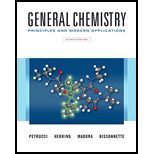
Concept explainers
Balance the following equations by inspection.
a.
b.
c.
d.
(a)
Interpretation:
Balance the following reaction by using inspection method.
Concept introduction:
Points for balancing the chemical equation:
- First, balance an element which occurs in only one compound present on both sides of the equation. Use fractions if required to balance an element.
- Then balance the atoms of element present in more amounts.
- In order to make fractions into whole number, use multiplication with suitable coefficient.
Answer to Problem 1E
The balanced equation is
Explanation of Solution
Given information:
The given equation is
Since, less number of atoms of sulfur is present in the equation so first balance sulfur atoms.
As per equation, number of sulfur atoms is equal on both sides.
Now, balance number of oxygen atoms.
To balance the oxygen atoms, multiply the oxygen molecule with half.
Multiply the whole equation with “2” to get co-efficient in whole number.
2× [
Thus, balanced equation is given by:
(b)
Interpretation:
Balance the following reaction by using inspection method.
Concept introduction:
Points for balancing the chemical equation:
- First, balance an element which occurs in only one compound present on both sides of the equation. Use fractions if required to balance an element.
- Then balance the atoms of element present in more amounts.
- In order to make fractions into whole number, use multiplication with suitable coefficient.
Answer to Problem 1E
The balanced chemical equation is:
Explanation of Solution
Given information:
The given equation is:
The more complex compound is Cl2O7, which has less common chlorine atom in it. So, balance chlorine atoms first.
The reactant side has two chlorine atoms and product has one chlorine atoms, so multiply
The above equation is balanced as number of oxygen and hydrogen atoms are equal on both sides.
(c)
Interpretation:
Balance the following reaction by using inspection method.
Concept introduction:
Points for balancing the chemical equation:
- First, balance an element which occurs in only one compound present on both sides of the equation. Use fractions if required to balance an element.
- Then balance the atoms of element present in more amounts.
- In order to make fractions into whole number, use multiplication with suitable coefficient.
Answer to Problem 1E
The balanced chemical equation is:
Explanation of Solution
Given information:
The given equation is
Since, least common atom is hydrogen atom so, first balance it on both the sides.
To balance hydrogen atoms, multiply
Now, balance the number of nitrogen atoms on both the sides by multiplying
Thus, above equation is balanced.
(d)
Interpretation:
Balance the following reaction by using inspection method.
Concept introduction:
Points for balancing the chemical equation:
- First, balance an element which occurs in only one compound present on both sides of the equation. Use fractions if required to balance an element.
- Then balance the atoms of element present in more amounts.
- In order to make fractions into whole number, use multiplication with suitable coefficient.
Answer to Problem 1E
The balanced equation is
Explanation of Solution
Given information:
The given equation is
The least common atom is chlorine so; first balance it on both sides.
To balance chlorine atoms, multiply
Now, balance hydrogen on both the sides by multiplying
Thus, above equation is balanced.
Want to see more full solutions like this?
Chapter 4 Solutions
General Chemistry: Principles and Modern Applications (11th Edition)
Additional Science Textbook Solutions
Biological Science (6th Edition)
Introductory Chemistry (6th Edition)
Anatomy & Physiology (6th Edition)
Microbiology: An Introduction
Brock Biology of Microorganisms (15th Edition)
Microbiology: An Introduction
- Synthesize 2-Ethyl-3-methyloxirane from dimethyl(propyl)sulfonium iodide using the necessary organic or inorganic reagents. Draw the structures of the compounds.arrow_forwardSynthesize 2-Hydroxy-2-phenylacetonitrile from phenylmethanol using the necessary organic or inorganic reagents. Draw the structures of the compounds.arrow_forwardSynthesize N-Methylcyclohexylamine from cyclohexanol using the necessary organic or inorganic reagents. Draw the structures of the compounds.arrow_forward
- Synthesize N-Methylcyclohexylamine from cyclohexanol using the necessary organic or inorganic reagents. Draw the structures of the compounds.arrow_forwardIf possible, please provide the formula of the compound 3,3-dimethylbut-2-enal.arrow_forwardSynthesize 1,4-dibromobenzene from acetanilide (N-phenylacetamide) using the necessary organic or inorganic reagents. Draw the structures of the compounds.arrow_forward
- Indicate the products obtained by mixing (3-oxo-3-phenylpropyl)triphenylphosphonium bromide with sodium hydride.arrow_forwardWe mix N-ethyl-2-hexanamine with excess methyl iodide and followed by heating with aqueous Ag2O. Indicate the major products obtained.arrow_forwardIndicate the products obtained by mixing acetophenone with iodine and NaOH.arrow_forward
- Indicate the products obtained by mixing 2-Propanone and ethyllithium and performing a subsequent acid hydrolysis.arrow_forwardIndicate the products obtained if (E)-2-butenal and 3-oxo-butanenitrile are mixed with sodium ethoxide in ethanol.arrow_forwardQuestion 3 (4 points), Draw a full arrow-pushing mechanism for the following reaction Please draw all structures clearly. Note that this intramolecular cyclization is analogous to the mechanism for halohydrin formation. COH Br + HBr Brarrow_forward
 ChemistryChemistryISBN:9781305957404Author:Steven S. Zumdahl, Susan A. Zumdahl, Donald J. DeCostePublisher:Cengage Learning
ChemistryChemistryISBN:9781305957404Author:Steven S. Zumdahl, Susan A. Zumdahl, Donald J. DeCostePublisher:Cengage Learning
 Chemistry: An Atoms First ApproachChemistryISBN:9781305079243Author:Steven S. Zumdahl, Susan A. ZumdahlPublisher:Cengage Learning
Chemistry: An Atoms First ApproachChemistryISBN:9781305079243Author:Steven S. Zumdahl, Susan A. ZumdahlPublisher:Cengage Learning Chemistry & Chemical ReactivityChemistryISBN:9781337399074Author:John C. Kotz, Paul M. Treichel, John Townsend, David TreichelPublisher:Cengage Learning
Chemistry & Chemical ReactivityChemistryISBN:9781337399074Author:John C. Kotz, Paul M. Treichel, John Townsend, David TreichelPublisher:Cengage Learning Chemistry for Engineering StudentsChemistryISBN:9781337398909Author:Lawrence S. Brown, Tom HolmePublisher:Cengage Learning
Chemistry for Engineering StudentsChemistryISBN:9781337398909Author:Lawrence S. Brown, Tom HolmePublisher:Cengage Learning Chemistry: The Molecular ScienceChemistryISBN:9781285199047Author:John W. Moore, Conrad L. StanitskiPublisher:Cengage Learning
Chemistry: The Molecular ScienceChemistryISBN:9781285199047Author:John W. Moore, Conrad L. StanitskiPublisher:Cengage Learning





